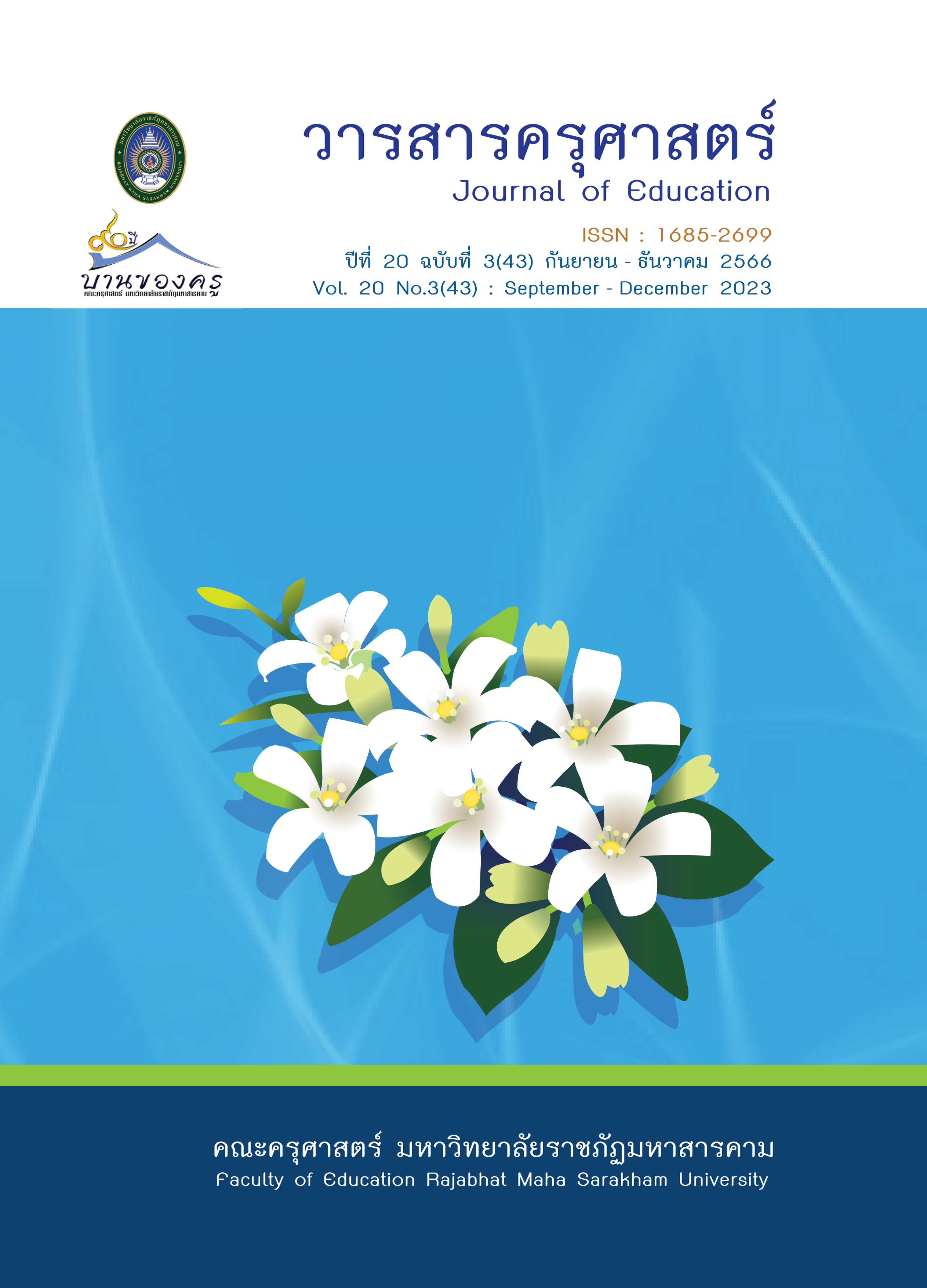Development of Information and Communication Technology Literacy Skills Using Blended Learning
Main Article Content
Abstract
This research aims to: 1) develop of blended learning to promote Information and communication Technology Literacy; 2) Compare students’ learning achievement before and after learning the developed management results using active learning management to promote Information and communication technology literacy; and 3) To study Information and communication technology literacy skills from the developed learning management model. The target group consists of 9 experts in learning management and digital technology and 25 students majoring in computer education by purposing sampling. The research instruments include: 1) Blended Learning to promote Information and communication Technology Literacy, 2) Lesson plan for the blended learning course 3) achievement of learning test and 4) Information and communication Technology Literacy assessment form.
The research findings indicate that: 1) The developed Blended Learning to promote Information and communication Technology Literacy is of the high quality (x̅=4.20, S.D.=0.69), 2) the students’ learning achievement after using Blended Learning to promote Information and communication Technology Literacy were higher than before learning at the statistically significant level of .05 and 3) The Information and communication technology literacy of the students who participated in the Blended Learning to promote Information and communication technology literacy are at good level, with 60 percent achieving the desired level.
Article Details

This work is licensed under a Creative Commons Attribution-NonCommercial-NoDerivatives 4.0 International License.
ข้อกำหนดเบื้องต้นที่ผู้นิพนธ์(ผู้ส่งบทความ) ควรทราบ
1. ผู้นิพนธ์ที่ประสงค์จะลงตีพิมพ์บทความกับวารสาร ตั้งแต่เดือนมกราคม 2563 เป็นต้นไป ให้ใช้รูปแบบใหม่ (Template 2563) โดยสามารถดูตัวอย่างได้ที่เมนู GUIDELINES
2. จะตีพิมพ์และเผยแพร่ได้ ต้องผ่านการประเมินจากผู้ทรงคุณวุฒิ (Peer Review)
3. การประเมินบทความโดยผู้ทรงคุณวุฒิ (Peer Review) เป็นแบบ Double Blind
4. การอ้างอิงบทความใช้หลักเกณฑ์ APA (American Psychological Association) คลิก
5. บทความถูกปฏิเสธการตีพิมพ์ ไม่ผ่านการประเมิน ผู้นิพนธ์ขอยกเลิกเองหรือชำระเงินก่อนได้รับการอนุมัติ ทางวารสารไม่มีนโยบายการคืนเงิน
References
กระทรวงการอุดมศึกษา วิทยาศาสตร์ วิจัย และนวัตกรรม. (2565) แผนด้านการอุดมศึกษาเพื่อผลิตและพัฒนากำลังคนของประเทศ ฉบับปรับปรุง พ.ศ.2566-2570.
กระทรวงการอุดมศึกษา วิทยาศาสตร์ วิจัย และนวัตกรรม. (2565). ประกาศคณะกรรมการมาตรฐานการอุดมศึกษา เรื่อง รายละเอียดผลลัพธ์การเรียนรู้ตามมาตรฐานคุณวุฒิระดับอุดมศึกษา พ.ศ.2565.
กระทรวงการอุดมศึกษา วิทยาศาสตร์ วิจัย และนวัตกรรม. (2566). แผนด้านการอุดมศึกษาเพื่อผลิตและพัฒนากำลังคนของประเทศ พ.ศ.2564-2570 ฉบับปรับปรุง 2566-2570.
จินตวีร์ คล้ายสังข์ และประกอบ กรณีกิจ. (2560). การพัฒนาแบบวัดและเกณฑ์ประเมินแบบรูบริคส์ออนไลน์ ด้านการรู้สารสนเทศ การรู้สื่อ และการรู้เทคโนโลยีสารสนเทศและการสื่อสารสำหรับผู้เรียนระดับอุดมศึกษา. โครงการมหาวิทยาลัยไซเบอร์ไทย สำนักงานคณะกรรมการการอุดมศึกษา.
จินตวีร์ คล้ายสังข์. (2562). บรรยายการอบรมเชิงวิชาการ เรื่อง การเรียนรู้แบบผสมผสาน (Blended Learning). http://qa.hcu.ac.th/km/fileuploads/Blended-learning-2562.pdf.
นารียะ เจะโนะ. (2564). การพัฒนารูปแบบการจัดการเรียนการสอนแบบผสมผสานที่ส่งเสริมผลสัมฤทธิ์ทางการเรียน วิชาทักษะการเรียนรู้สำหรับนักเรียนมัธยมศึกษาตอนต้น ศูนย์การศึกษานอกระบบและการศึกษาตามอัธยาศัยอำเภอปะนาเระ จังหวัดปัตตานี [ปริญญาศึกษาศาสตรมหาบัณฑิต]. มหาวิทยาลัยสงขลานครินทร์.
บุญชม ศรีสะอาด. (2555). การวิจัยเบื้องต้น (พิมพ์ครั้งที่ 9). สุวีริยาสาส์น.
บุญเลี้ยง ทุมทอง. (2556). หลักสูตรและการจัดการเรียนรู้. สุวิริยาสาสน์.
วัชรา เล่าเรียนดี, ปรณัฐ กิจรุ่งเรือง และ อรพิณ ศิริสัมพันธ์. (2560). กลยุทธ์การจัดการเรียนรู้เชิงรุก เพื่อพัฒนาการคิดและยกระดับคุณภาพการศึกษา สำหรับศตวรรษที่ 21. บริษัท เพชรเกษมพริ้นติ้ง กรุ๊ป.
วิไลวรรณ วงศ์จินดา และ นนทโชติ อุดมศรี. (2565). การศึกษาพฤติกรรมและทักษะการรู้ทันสื่อสังคมออนไลน์ สำหรับนักศึกษาคณะครุศาสตรอุตสาหกรรม มหาวิทยาลัยเทคโนโลยีราชมงคลสุวรรณภูมิ. วารสารวิชาการมหาวิทยาลัยราชภัฏศรีสะเกษ, 16(1),101-109.
ศักดิ์ชัย นันทราช, สำราญ กำจัดภัย และ อุษา ปราบหงส์. (2561). ผลการจัดการเรียนรู้ตามแนวคิดการเรียนรู้แบบผสมผสาน รายวิชา เทคโนโลยีสารสนเทศและการสื่อสาร ชั้นมัธยมศึกษาปีที่ 5. วารสารวิชาการหลักสูตรและการสอน มหาวิทยาลัยราชภัฏสกลนคร, 10(29), 35-43.
Allen, I. E., & Seaman, J. (2005). Growing by Degree : Online Education in the United States. https://files.eric.ed.gov/fulltext/ED530063.pdf.
Bernath, R. (2012). Effectives Approaches to Blended Learning for Independent Schools. http://www.testden.com/partner/ blended%20learn.html.
Carman, J. M. (2005). Blended Learning Design : Five Key Ingredients. http://www.agilantlearning.com/pdf/Blended%20Learning%20Design.pdf. Retrieved on 20 July 2022.
Christensen, C. M., Horn, M. B., & Staker, H. (2013). Is K-12 blended learning disruptive? An introduction of the theory of hybrids. San Mateo: Clayton Christensen Institute. http://www.christenseninstitute.org/wp-content/uploads/2013/05/Is-K-12-Blended-Learning-Disruptive.pdf.
Driscoll, M. (2002). Blended Learning : Let’s get beyond the hype. https://www.researchgate.net/publication/286029739_Blended_learning_Let’s_get_beyond_the_hype.
Graham, C.R. (2012). Introduction to Blended Learning. http://www.media.wiley.com/product_data/except/86/C.pdf.
Mahalli., Nurkamto, J., Mujiyanto. J, & Yuliasri. I. (.2020). Students’ Perception of Blended Learning Implementation in EFL Learning. International Journal of Innovation, Creativity and Change. 11(8), 161-172.
Oliver, M., & Trigwell, K. (2005). Can Blended Learning Be Redeemed?. E-Learning and Digital Media. 2(1), 17–26. https://doi.org/ 10.2304/elea.2005.2.1.17.


